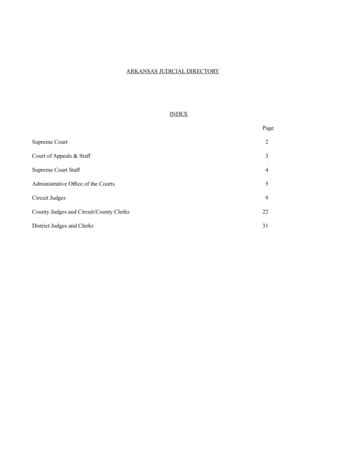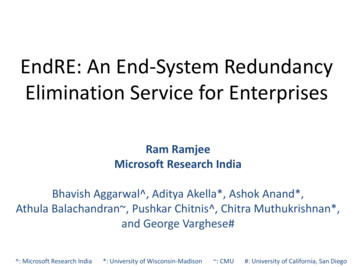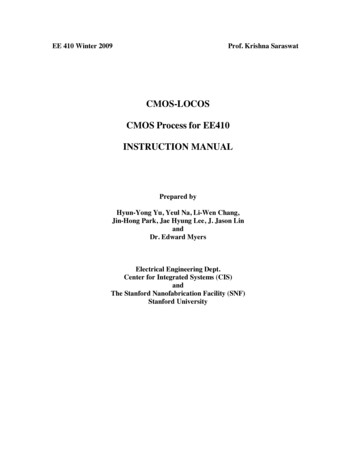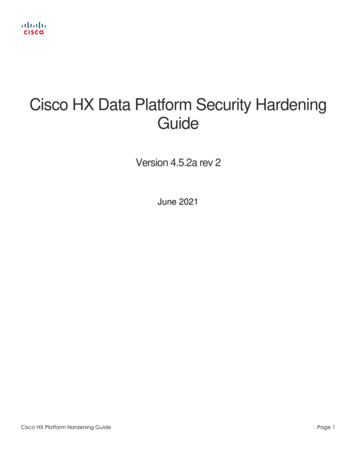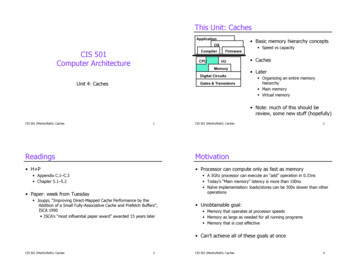
Transcription
This Unit: CachesApplication ! Basic memory hierarchy conceptsOSCompilerCIS 501Computer ArchitectureCPUFirmwareI/OMemoryDigital CircuitsUnit 4: CachesGates & Transistors ! Speed vs capacity ! Caches ! Later ! Organizing an entire memoryhierarchy ! Main memory ! Virtual memory ! Note: much of this should bereview, some new stuff (hopefully)CIS 501 (Martin/Roth): Caches1CIS 501 (Martin/Roth): CachesReadingsMotivation ! H P ! Processor can compute only as fast as memory ! Appendix C.1–C.3 ! Chapter 5.1–5.22 ! A 3Ghz processor can execute an “add” operation in 0.33ns ! Today’s “Main memory” latency is more than 100ns ! Naïve implementation: loads/stores can be 300x slower than otheroperations ! Paper: week from Tuesday ! Jouppi, “Improving Direct-Mapped Cache Performance by theAddition of a Small Fully-Associative Cache and Prefetch Buffers”,ISCA 1990 ! ISCA’s “most influential paper award” awarded 15 years later ! Unobtainable goal: ! Memory that operates at processor speeds ! Memory as large as needed for all running programs ! Memory that is cost effective ! Can’t achieve all of these goals at onceCIS 501 (Martin/Roth): Caches3CIS 501 (Martin/Roth): Caches4
Review: Types of MemoryMemory & Storage Technologies ! Static RAM (SRAM) ! Cost - what can 200 buy today? ! 6 transistors per bit (two inverters, two other transistors for off/on) ! Optimized for speed (first) and density (second) ! Fast (sub-nanosecond latencies for small SRAM) ! Speed proportional to its area ! Mixes well with standard processor logic ! Dynamic RAM (DRAM) ! ! ! !1 transistor 1 capacitor per bitOptimized for density (in terms of cost per bit)Slow ( 40ns internal access, 100ns pin-to-pin)Different fabrication steps (does not mix well with logic) ! Latency ! SRAM - 1 to 5ns (on chip) ! DRAM - 100ns --- 100x or more slower ! Disk - 10,000,000ns or 10ms --- 100,000x slower (mechanical) ! Bandwidth ! SRAM - 10-1000GB/sec ! DRAM - 10GB/sec ! Disk - 100MB/sec (0.1 GB/sec) - sequential access only ! Aside: Flash, a non-traditional (and nonvolatile) memory ! Nonvolatile storage: Magnetic disk, Flash RAMCIS 501 (Martin/Roth): Caches ! SRAM: 16MB ! DRAM: 4,000MB (4GB) --- 250x cheaper than SRAM ! Disk: 1,000,000MB (1TB) --- 250x cheaper than DRAM ! 32GB for 200, 8x cheaper than DRAM! (But 32x more than disk)5Storage Technology TrendsCIS 501 (Martin/Roth): Caches6The “Memory Wall” 35 to 55%CostLog scale 7%Copyright Elsevier Scientific 2003 ! Processors are get faster more quickly than memory (note log scale)Copyright Elsevier Scientific 2003CIS 501 (Martin/Roth): Caches ! Processor speed improvement: 35% to 55% ! Memory latency improvement: 7%Access Time7CIS 501 (Martin/Roth): Caches8
Known From the BeginningLocality to the Rescue ! Locality of memory references“Ideally, one would desire an infinitely large memorycapacity such that any particular word would beimmediately available We are forced to recognize thepossibility of constructing a hierarchy of memories, eachof which has a greater capacity than the preceding butwhich is less quickly accessible.”Burks, Goldstine, VonNeumann“Preliminary discussion of the logical design of anelectronic computing instrument”IAS memo 1946CIS 501 (Martin/Roth): Caches9Library Analogy ! Property of real programs, few exceptions ! Books and library analogy (next slide) ! Temporal locality ! Recently referenced data is likely to be referenced again soon ! Reactive: cache recently used data in small, fast memory ! Spatial locality ! More likely to reference data near recently referenced data ! Proactive: fetch data in large chunks to include nearby data ! Holds for data and instructionsCIS 501 (Martin/Roth): CachesExploiting Locality: Memory Hierarchy ! Consider books in a libraryCPU ! Library has lots of books, but it is slow to accessM1 ! Far away (time to walk to the library) ! Big (time to walk within the library)M2 ! Hierarchy of memory components ! Upper components ! Fast ! Small ! Expensive ! Lower components ! Slow ! Big ! Cheap ! Connected by “buses” ! Which also have latency and bandwidth issues ! How can you avoid these latencies? ! Check out books, take them home with you ! Put them on desk, on bookshelf, etc. ! But desks & bookshelves have limited capacity ! Keep recently used books around (temporal locality) ! Grab books on related topic at the same time (spatial locality) ! Guess what books you’ll need in the future (prefetching)CIS 501 (Martin/Roth): Caches1011 ! Most frequently accessed data in M1M3 ! M1 next most frequently accessed in M2, etc. ! Move data up-down hierarchy ! Optimize average access timeM4CIS 501 (Martin/Roth): Caches ! latencyavg latencyhit %miss * latencymiss ! Attack each component12
Concrete Memory HierarchyProcessorRegsI D L2 ! 0th level: Registers ! 1st level: Primary cachesCompilerManaged ! Registers ! books on your desk ! Actively being used, small capacity ! Split instruction (I ) and data (D ) ! Typically 8KB to 64KB each ! 2nd level: Second-level cache (L2 )Hardware ! On-chip, certainly on-package (with CPU)Managed ! Made of SRAM (same circuit type as CPU) ! Typically 512KB to 16MBMainMemory ! 3rd level: main memorySoftwareManaged(by OS)DiskLibrary Analogy Revisited ! Made of DRAM (“Dynamic” RAM) ! Typically 1GB to 4GB for desktops/laptops ! Servers can have 100s of GB ! Caches ! bookshelves ! Moderate capacity, pretty fast to access ! Main memory ! library ! Big, holds almost all data, but slow ! Disk (swap) ! inter-library loan ! Very slow, but hopefully really uncommon ! 4th level: disk (swap and files)CIS 501 (Martin/Roth): Caches ! Uses magnetic disks13Evolution of Cache Hierarchies14This Unit: Caches ! “Cache”: hardware managedCPU64KB I 8KBI/D CIS 501 (Martin/Roth): Caches ! Hardware automatically retrieves missing data ! Built from fast SRAM, usually on-chip today ! In contrast to off-chip, DRAM “main memory”64KB D I D ! Cache organization ! ABC ! Miss classificationL21.5MB L2 ! High-performance techniquesMainMemoryL3 tagsIntel 486 ! Some example performance calculationsIBM Power5 (dual core)Disk ! Chips today are 30–70% cache by areaCIS 501 (Martin/Roth): Caches ! Reducing misses ! Improving miss penalty ! Improving hit latency15CIS 501 (Martin/Roth): Caches16
Looking forward: Memory and Disk ! Number of entries ! DRAM-based memory systems ! Virtual memory ! 2n, where n is number of address bits ! Example: 1024 entries, 10 bit address ! Decoder changes n-bit address to2n bit “one-hot” signal ! One-bit address travels on “wordlines”D ! Disks and StorageL2 ! Properties of disks ! Disk arrays (for performance and reliability) ! Size of entriesMainMemory ! Width of data accessed ! Data travels on “bitlines” ! 256 bits (32 bytes) in example011024*256bitSRAM2310 bitswordlines ! Main memoryCPUI Basic Memory Array Structure102110221023bitlinesDiskCIS 501 (Martin/Roth): Caches17FYI: Physical Memory Layout ! Logical layout ! Arrays are vertically contiguous ! Physical layout - roughly square ! Vertical partitioning to minimize wire lengths ! H-tree: horizontal/vertical partitioning layout ! Applied recursively ! Each node looks like an H18Physical Cache Layout0512151325576725676851010225111023addressCIS 501 (Martin/Roth): CachesCIS 501 (Martin/Roth): Caches ! Arrays and h-trees make caches easy to spot in µgraphsdata19CIS 501 (Martin/Roth): Caches20
Caches: Finding Data via Indexing0 ! Example: 32KB cache (1024 frames, 32B blocks) ! “Hash table in hardware”CIS 501 (Martin/Roth): Caches10221023bitlinesaddress0 ! All blocks with same index bit pattern1tag [31:15]21index [14:5]CIS 501 (Martin/Roth): Caches10221023 [4:0]addressCalculating Tag OverheadHandling a Cache Miss ! “32KB cache” means cache holds 32KB of data ! What if requested data isn’t in the cache? ! Called capacity ! Tag storage is considered overhead31021 ! Read frame indicated by index bits ! “Hit” if tag matches and valid bit is set ! Otherwise, a “miss”. Get data from next level data2 ! How to know which if any is currently there? ! Lookup algorithm1021[4:0] ! Each frame can hold one of 217 blocks ! To each frame attach tag and valid bit ! Compare frame tag to address tag bits ! No need to match index bits (why?)wordlines ! Which part? ! 32-bit address ! 32B blocks " 5 lowest bits locate byte in block ! These are called offset bits ! 1024 frames " next 10 bits find frame ! These are the index bits ! Note: nothing says index must be these bits ! But these work best (think about why)index [14:5]23 ! To find frame: decode part of address[31:15]1024*256bitSRAM1wordlines ! Basic cache: array of block framesKnowing that You Found It: Tags data hit?22 ! How does it get in there? ! Cache controller: finite state machine ! Tag overhead of 32KB cache with 1024 32B frames ! ! ! ! !32B frames " 5-bit offset1024 frames " 10-bit index32-bit address – 5-bit offset – 10-bit index 17-bit tag(17-bit tag 1-bit valid)* 1024 frames 18Kb tags 2.2KB tags 6% overhead ! ! ! !Remembers miss addressAccesses next level of memoryWaits for responseWrites data/tag into proper locations ! All of this happens on the fill path ! Sometimes called backside ! What about 64-bit addresses? ! Tag increases to 49bits, 20% overhead (worst case)CIS 501 (Martin/Roth): Caches23CIS 501 (Martin/Roth): Caches24
Cache Performance EquationCPI Calculation with Cache Misses ! For a cache ! Parameters ! Access: read or write to cache ! Hit: desired data found in cache ! Miss: desired data not found in cache ! Must get from another component ! No notion of “miss” in register file ! Fill: action of placing data into cachethitCache%miss ! ! ! ! ! %miss (miss-rate): #misses / #accesses ! thit: time to read data from (write data to) cache ! tmiss: time to read data into cachetmissSimple pipeline with base CPI of 1Instruction mix: 30% loads/storesI : %miss 2%, tmiss 10 cyclesD : %miss 10%, tmiss 10 cycles ! What is new CPI? ! CPII %missI *tmiss 0.02*10 cycles 0.2 cycle ! CPID %load/store*%missD *tmissD 0.3 * 0.1*10 cycles 0.3 cycle ! CPInew CPI CPII CPID 1 0.2 0.3 1.5 ! Performance metric: average access timetavg thit %miss * tmissCIS 501 (Martin/Roth): Caches25CIS 501 (Martin/Roth): Caches26Measuring Cache PerformanceCache Miss Paper Simulation ! Ultimate metric is tavg ! 4-bit addresses " 16B memory ! Simpler cache diagrams than 32-bits ! Cache capacity and circuits roughly determines thit ! Lower-level memory structures determine tmiss ! Measure %miss ! Hardware performance counters ! Simulation (homework) ! Paper simulation (next) ! 8B cache, 2B blocks ! Figure out number of sets: 4 (capacity / block-size) ! Figure out how address splits into offset/index/tag bits ! Offset: least-significant log2(block-size) log2(2) 1 " 0000 ! Index: next log2(number-of-sets) log2(4) 2 " 0000 ! Tag: rest 4 – 1 – 2 1 " 0000 ! Cache diagram ! 0000 0001 are addresses of bytes in this block, values don’t matterCache contentsSet00Set01AddressSet10OutcomeSet110000 0001 0010 0011 0100 0101 0110 0111CIS 501 (Martin/Roth): Caches27CIS 501 (Martin/Roth): Caches28
4-bit Address, 8B Cache, 2B Blocks0000A0001Main memory4-bit Address, 8B Cache, 2B 1F0101Ftag (1 bit)index (2 bits)1 bitDataSetTag01Main memorytag (1 bit)Load: 1110index (2 IS 501 (Martin/Roth): Caches294-bit Address, 8B Cache, 2B Blocks0000A0001B0010C0011D0100E0101F0110Main memoryLoad: 1110tag (1 bit)index (2 bits)Set00Set01Set10index (2 bits)AddressOutcomeMiss0000 0001 0010 0011 1100 1101 1110 1111 1000Miss1000 1001 0010 0011 1100 1101 1110 1111 0011HitF1000 1001 0010 0011 1100 1101 1110 1111 1000HitQ1000 1001 0010 0011 1100 1101 1110 1111 0000Miss0000 0001 0010 0011 1100 1101 1110 1111 100M1101N1 bitSet11Miss00CIS 501 (Martin/Roth): Cachestag (1 bit)0000 0001 0010 0011 1100 1101 0110 0111 1110GP ! 8B cache, 2B blocks0000 0001 0010 0011 0100 0101 0110 0111 11001Q1 bitData0111130Cache contents (prior to access)Tag1110CIS 501 (Martin/Roth): CachesCache Miss Paper SimulationMissSet1 bit ! How to reduce %miss? And hopefully tavg?31CIS 501 (Martin/Roth): Caches32
Capacity and PerformanceBlock Size ! Simplest way to reduce %miss: increase capacity ! Given capacity, manipulate %miss by changing organization ! One option: increase block size512*512bit ! Miss rate decreases monotonically ! “Working set”: insns/data program is actively using ! Diminishing returns–! However thit increases ! Latency proportional tosqrt(capacity) ! tavg ?%missSRAM ! Exploit spatial locality ! Notice index/offset bits change ! Tag remain the same012 ! Ramifications ! Reduce %miss (up to a point) ! Reduce tag overhead (why?)–! Potentially useless data transfer–! Premature replacement of useful data–! Fragmentation“working set” sizeCache Capacity[31:15]5105119-bit[14:6] ! Given capacity, manipulate %miss by changing organizationCIS 501 (Martin/Roth): Caches33Block Size and Tag Overhead32B frames " 5-bit offset1024 frames " 10-bit index32-bit address – 5-bit offset – 10-bit index 17-bit tag(17-bit tag 1-bit valid) * 1024 frames 18Kb tags 2.2KB tags 6% overhead addressCIS 501 (Martin/Roth): Caches0000A0001B0010C0011D0100E0101F01100111 ! Tag overhead of 32KB cache with 512 64B frames ! 64B frames " 6-bit offset ! 512 frames " 9-bit index ! 32-bit address – 6-bit offset – 9-bit index 17-bit tag ! (17-bit tag 1-bit valid) * 512 frames 9Kb tags 1.1KB tags ! 3% overheadCIS 501 (Martin/Roth): Caches[5:0]data hit?344-bit Address, 8B Cache, 4B Blocks ! Tag overhead of 32KB cache with 1024 32B frames ! ! ! ! ! block size#35Main memoryLoad: 1110tag (1 bit)index (1 1011L1100M1101N1110P1111QCIS 501 (Martin/Roth): Caches2 bitSet Tag36
4-bit Address, 8B Cache, 4B Blocks0000A0001BMain memorytag (1 bit)index (1 01J1010K1011L1100M1101N1110P1111QLoad: 1110Block Size Cache Miss Paper Simulation2 bitMisstag (1 bit)Cache contents (prior to access)00010100 0101 0110 01111100Miss1100 1101 1110 11111110Hit (spatial locality)0000 0001 0010 00111100 1101 1110 11111000Miss1000 1001 1010 10111100 1101 1110 11110011Miss0000 0001 0010 00111100 1101 1110 11111000Miss1000 1001 1010 10111100 1101 1110 11110000Miss0000 0001 0010 00111100 1101 1110 11111000Miss110000 0001 0010 0011CD0000 0001 0010 0011PQ ! Spatial “prefetching”: miss on 1100 brought in 1110–! Conflicts: miss on 1000 kicked out 0011CIS 501 (Martin/Roth): Caches37CIS 501 (Martin/Roth): CachesEffect of Block Size on Miss RateBlock Size and Miss Penalty ! Two effects on miss rate ! Does increasing block size increase tmiss? ! Spatial prefetching (good) ! For blocks with adjacent addresses ! Turns miss/miss into miss/hit pairs %miss–! Interference (bad) ! For blocks with non-adjacentaddresses (but in adjacent frames) ! Turns hits into misses by disallowingsimultaneous residence ! Consider entire cache as one big block38 ! Don’t larger blocks take longer to read, transfer, and fill? ! They do, but ! tmiss of an isolated miss is not affected ! Critical Word First / Early Restart (CRF/ER) ! Requested word fetched first, pipeline restarts immediately ! Remaining words in block transferred/filled in the backgroundBlock Size ! Both effects always present ! tmiss’es of a cluster of misses will suffer ! Spatial prefetching dominates initially ! Depends on size of the cache ! Good block size is 16–128B ! Program dependentCIS 501 (Martin/Roth): Caches2 bitsOutcomeSet110index (1 bit)AddressSet0DataSet Tag ! 8B cache, 4B blocks ! Reads/transfers/fills of two misses can’t happen at the same time ! Latencies can start to pile up ! This is a bandwidth problem (more later)39CIS 501 (Martin/Roth): Caches40
ConflictsSet-Associativitytag (1 bit)index (2 bits)Cache contents (prior to access)Set00Set01Set10Address ! ! ! ! ! !OutcomeSet110000 0001 0010 0011 0100 0101 0110 0111 1100Miss0000 0001 0010 0011 1100 1101 0110 0111 1110Miss0000 0001 0010 0011 1100 1101 1110 1111 1000Miss1000 1001 0010 0011 1100 1101 1110 1111 0011Hit1000 1001 0010 0011 1100 1101 1110 1111 1000Hit1000 1001 0010 0011 1100 1101 1110 1111 0000Miss0000 0001 0010 0011 1100 1101 1110 1111 1000MissBlock can reside in one of few framesFrame groups called setsEach frame in set called a wayThis is 2-way set-associative (SA)1-way " direct-mapped (DM)1-set " fully-associative (FA) ! Regardless of block-size (assuming capacity 16) ! Q: can we allow pairs like these to simultaneously reside? ! A: yes, reorganize cache to do so ! Note: valid bit not shownCIS 501 (Martin/Roth): Caches415121513251451010225111023 9-bitassociativity#[31:14][13:5][4:0]addressCIS 501 (Martin/Roth): CachesSet-Associativity0 ! Reduces conflicts–! Increases latencyhit: ! additional tag match & muxing ! Pairs like 0000/1000 conflict data42hit?Associativity and Miss Paper Simulationways ! Lookup algorithm051215132514 ! Notice tag/index/offset bits ! Only 9-bit index (versus 10-bitfor direct mapped) ! Notice block 0000 0001 0100 0101 0010 0011 0110 0111 1100Miss10221100 1101 0100 0101 0010 0011 0110 0111 1110Miss51110231100 1101 0100 0101 1110 1111 0110 0111 1000Miss1100 1101 1000 1001 1110 1111 0110 0111 0011Miss (new conflict)1100 1101 1000 1001 1110 1111 0010 0011 1000Hit1100 1101 1000 1001 1110 1111 0010 0011 0000Miss0000 0001 1000 1001 1110 1111 0010 0011 1000Hit (avoid conflict) ! Avoid conflicts: 0000 and 1000 can both be in set 0–! Introduce some new conflicts: notice address re-arrangement ! Happens, but conflict avoidance usually 14] ! 8B cache, 2B blocks, 2-way set-associativeCache contents (prior to access)sets ! Use index bits to find set ! Read data/tags in all frames in parallel ! Any (match and valid bit), HitCIS 501 (Martin/Roth): Cachesways ! Set-associativity1 bitsets ! 8B cache, 2B blocks[4:0]address data43hit?CIS 501 (Martin/Roth): Caches44
Replacement PoliciesNMRU and Miss Handling ! Set-associative caches present a new design choice ! Add LRU field to each set ! On cache miss, which block in set to replace (kick out)? ! “Least recently used” ! LRU data is encoded “way” ! Hit? update MRU ! Some options ! LRU bits updated on eachaccess[31:15] ! Which policy is simulated in previous example?CIS 501 (Martin/Roth): Caches454-bit Address, 8B Cache, 2B Blocks, 2-way0000A0001Main 1F0110GSet0110H001111000I11001J10101011Way 0LRUWay 1Data1DataTag01Main memoryLoad: 11101023 data46index (1 bits)hit?Way 0LRUWay 1101N1101N1110P1110P1111Q1111QCIS 501 (Martin/Roth): Caches1 bitMiss047511[4:0]tag (2 bit)TagCIS 501 (Martin/Roth): Caches0513addressSet0111Tag1 bit51214-bit Address, 8B Cache, 2B Blocks, 2-wayAindex (1 bits)[14:5]CIS 501 (Martin/Roth): Caches0000tag (2 bit)0WE ! Random ! FIFO (first-in first-out) ! LRU (least recently used) ! Fits with temporal locality, LRU least likely to be used in future ! NMRU (not most recently used) ! An easier to implement approximation of LRU ! Is LRU for 2-way set-associative caches ! Belady’s: replace block that will be used furthest in future ! Unachievable optimumdata from memoryDataTag01001EF101GH48
4-bit Address, 8B Cache, 2B Blocks, 2-wayMain 111Qtag (2 bit)Load: 1110index (1 bits)1 bitParallel or Serial Tag Access? ! Note: data and tags actually physically separate ! Split into two different arraysMissWay 0LRU ! Parallel access example:Way 1DataDatatagTag01001EF011PQ2-bit indexoffset2-bitFour blocks transferred2-bit LRU updated on each access(not just misses)CIS 501 (Martin/Roth): Caches 49CIS 501 (Martin/Roth): CachesSerial Tag AccessBest of Both? Way Prediction ! Tag match first, then access only one data block ! Predict “way” of block ! ! ! ! ! Advantages: lower power, fewer wires/pins ! Disadvantages: slowtag2-bit indexoffset2-bitSerialCPUTagstagParallelTags2-bit indexoffset2-bit ! AdvantagesChip boundaryCPUJust a “hint”Use the index plus some tag bitsTable of n-bit entries for 2n associative cacheUpdate on mis-prediction or replacement4-bitData ! Fast ! Low-powerChip boundaryCIS 501 (Martin/Roth): Caches4-bit ! Disadvantage2-bitDataWayPredictor ! More “misses”Only one block transferreddata CIS 501 (Martin/Roth): Caches2-bit 5150datahitdata 52
Associativity And PerformanceClassifying Misses: 3C Model (Hill) ! Higher associative caches ! Divide cache misses into three categories ! Have better (lower) %miss ! Diminishing returns–! However thit increases ! The more associative, the slower ! What about tavg?%miss 5Associativity ! Block-size and number of sets should be powers of two ! Makes indexing easier (just rip bits out of the address) ! Calculated by multiple simulations ! 3-way set-associativity? No problemCIS 501 (Martin/Roth): Caches ! Compulsory (cold): never seen this address before ! Would miss even in infinite cache ! Capacity: miss caused because cache is too small ! Would miss even in fully associative cache ! Identify? Consecutive accesses to block separated by access toat least N other distinct blocks (N is number of frames in cache) ! Conflict: miss caused because cache associativity is too low ! Identify? All other misses ! (Coherence): miss due to external invalidations ! Only in shared memory multiprocessors (later) ! Simulate infinite cache, fully-associative cache, normal cache ! Subtract to find each count53CIS 501 (Martin/Roth): Caches54Miss Rate: ABCReducing Conflict Misses: Victim Buffer ! Why do we care about 3C miss model? ! Conflict misses: not enough associativity ! So that we know what to do to eliminate misses ! If you don’t have conflict misses, increasing associativity won’t help ! High-associativity is expensive, but also rarely needed ! 3 blocks mapping to same 2-way set and accessed (XYZ) ! Associativity ! Victim buffer (VB): small fully-associative cache ! Decreases conflict misses–! Increases latencyhit ! ! ! ! !Sits on I /D miss pathSmall so very fast (e.g., 8 entries)Blocks kicked out of I /D placed in VBOn miss, check VB: hit? Place block back in I /D 8 extra ways, shared among all sets !Only a few sets will need it at any given time ! Very effective in practice ! Does VB reduce %miss or latencymiss? ! Block size–! Increases conflict/capacity misses (fewer frames) ! Decreases compulsory/capacity misses (spatial locality) ! No significant effect on latencyhit ! Capacity ! Decreases capacity misses–! Increases latencyhitCIS 501 (Martin/Roth): Caches55CIS 501 (Martin/Roth): CachesI /D VBL256
Overlapping Misses: Lockup Free CacheSoftware Restructuring: Data ! Lockup free: allows other accesses while miss is pending ! Capacity misses: poor spatial or temporal locality ! Consider: Load [r1] - r2; Load [r3] - r4; Add r2, r4 - r5 ! Handle misses in parallel ! “memory-level parallelism” ! Makes sense for ! Processors that can go ahead despite D miss (out-of-order) ! Implementation: miss status holding register (MSHR) ! Remember: miss address, chosen frame, requesting instruction ! When miss returns know where to put block, who to inform ! Common scenario: “hit under miss” ! Handle hits while miss is pending ! Easy ! Less common, but common enough: “miss under miss” ! A little trickier, but common anyway ! Requires multiple MSHRs: search to avoid frame conflictsCIS 501 (Martin/Roth): Caches57 ! Several code restructuring techniques to improve both–! Compiler must know that restructuring preserves semantics ! Loop interchange: spatial locality ! Example: row-major matrix: X[i][j] followed by X[i][j 1] ! Poor code: X[I][j] followed by X[i 1][j]for (j 0; j NCOLS; j )for (i 0; i NROWS; i )sum X[i][j];// say ! Better codefor (i 0; i NROWS; i )for (j 0; j NCOLS; j )sum X[i][j];CIS 501 (Martin/Roth): Caches58Software Restructuring: DataSoftware Restructuring: Code ! Loop blocking: temporal locality ! Compiler an layout code for temporal and spatial locality ! Poor codefor (k 0; k NITERATIONS; k )for (i 0; i NELEMS; i )sum X[i];// say ! Better code ! Cut array into CACHE SIZE chunks ! Run all phases on one chunk, proceed to next chunkfor (i 0; i NELEMS; i CACHE SIZE)for (k 0; k NITERATIONS; k )for (ii 0; ii i CACHE SIZE-1; ii )sum X[ii]; ! If (a) { code1; } else { code2; } code3; ! But, code2 case never happens (say, error condition)Betterlocality–! Assumes you know CACHE SIZE, do you? ! Loop fusion: similar, but for multiple consecutive loopsCIS 501 (Martin/Roth): CachesBetterlocality ! Fewer taken branches, too ! Intra-procedure, inter-procedure59CIS 501 (Martin/Roth): Caches60
PrefetchingSoftware Prefetching ! Prefetching: put blocks in cache proactively/speculatively ! Use a special “prefetch” instruction ! Key: anticipate upcoming miss addresses accurately ! Can do in software or hardware ! Tells the hardware to bring in data, doesn’t actually read it ! Just a hint ! Simple example: next block prefetching ! Miss on address X " anticipate miss on X block-size !Works for insns: sequential executionI /D !Works for data: arrays ! Timeliness: initiate prefetches sufficiently in advance ! Coverage: prefetch for as many misses as possibleprefetch logic ! Accuracy: don’t pollute with unnecessary dataL2 ! It evicts useful dataCIS 501 (Martin/Roth): Caches61 ! Inserted by programmer or compiler ! Examplefor (i 0; i NROWS; i )for (j 0; j NCOLS; j BLOCK SIZE) {prefetch(&X[i][j] BLOCK SIZE);for (jj j; jj j BLOCK SIZE-1; jj )sum x[i][jj];} ! Multiple prefetches bring multiple blocks in parallel ! Using lockup-free caches ! “Memory-level” parallelismCIS 501 (Martin/Roth): Caches62Hardware PrefetchingMore Advanced Address Prediction ! What to prefetch? ! “Next-block” prefetching is easy, what about other options? ! Correlating predictor ! Stride-based sequential prefetching ! Can also do N blocks ahead to hide more latency !Simple, works for sequential things: insns, array data !Works better than doubling the block size ! Address-prediction ! Needed for non-sequential data: lists, trees, etc. ! Use a hardware table to detect strides, common patterns ! Large table stores (miss-addr " next-miss-addr) pairs ! On miss, access table to find out what will miss next ! It’s OK for this table to be large and slow ! Content-directed or dependence-based prefetching ! Greedily chases pointers from fetched blocks ! Jump pointers ! Augment data structure with prefetch pointers ! When to prefetch? ! Make it easier to prefetch: cache-conscious layout/malloc ! On every reference? ! On every miss?CIS 501 (Martin/Roth): Caches ! Lays lists out serially in memory, makes them look like array ! Active area of research63CIS 501 (Martin/Roth): Caches64
Capacity Misses: CompressionWrite Issues ! Compression: store insns/data in compressed form ! So far we have looked at reading from cache ! Increase effective capacity–! Increase latencyhit (may have to decompress) ! Decompression algorithm must be fast (i.e., not LZW) ! Instruction fetches, loads ! What about writing into cache ! Stores, not an issue for instruction caches (why they are simpler) ! Pretty straightforward for I [Game , IBM’99] ! Compression performed statically ! No layout “holes” ! No need to modify cache itself (e.g., with additional tags) ! Can use a “dictionary” approach (e.g., IBM CodePack for PowerPC) ! Several new issues ! ! ! !Tag/data accessWrite-through vs. write-backWrite-allocate vs. write-not-allocateHiding write miss latency ! More difficult (but doable) for D , L2 [Alameldeen , ISCA’04]CIS 501 (Martin/Roth): Caches65CIS 501 (Martin/Roth): Caches66Tag/Data AccessWrite Propagation ! Reads: read tag and data in parallel ! When to propagate new value to (lower level) memory? ! Tag mis-match " data is garbage (OK, stall until good data arrives) ! On hit, update cache ! Immediately send the write to the next level ! Writes: read tag, write data in parallel? ! Tag mis-match " clobbered data (oops) ! For associative caches, which way was written into? ! Option #2: Write-back: when block is replaced ! Requires additional “dirty” bit per block ! Replace clean block: no extra traffic ! Replace dirty block: extra “writeback” of block2 ! Writeback-buffer: keep it off critical path of miss1 ! Step#1: Send “fill” request to next-levelWBB4 ! Step#2: While waiting, write dirty block to buffer3 ! Step#3: When new blocks arrives, put it into cacheNext-level- ! Step#4: Write buffer contents to next-level ! Writes are a pipelined two step (multi-cycle) process ! ! ! !Step 1: match tagStep 2: write to matching wayBypass (with address check) to avoid load stallsMay introduce structural hazardsCIS 501 (Martin/Roth): Caches ! Option #1: Write-through: immediately67CIS 501 (Martin/Roth): Caches68
Write Propagation ComparisonWrite Miss Handling ! Write-through ! How is a write miss actually handled?–! Requires additional bus bandwidth ! Consider repeated write hits–! Next level must handle small writes (1, 2, 4, 8-bytes) ! No need for valid bits in cache ! No need to handle “writeback” operations ! Simplifies miss handling (no WBB) ! Sometimes used for L1 caches (for example, by IBM) ! Write-allocate: fill block from next level, then write it ! Decreases read misses (next read to block will hit)–! Requires additional bandwidth ! Commonly used (especially with write-back caches) ! Write-back ! Write-non-allocate: just write to next level, no allocate ! Key advantage: uses less bandwidth ! Reverse of other pros/cons above ! Used by Intel and AMD ! Second-level and beyond are generally write-back cachesCIS 501 (Martin/Roth): Caches–! Potentiall
Main memory ! Virtual memory ! Note: much of this should be review, some new stuff (hopefully) Application OS Compiler Firmware I/OCPU Memory Digital Circuits Gates & Transistors CIS 501 (Martin/Roth): Caches 3 Readings ! H P ! Appendix C.1–C.3 ! Chapter 5.1–5.2 ! Paper: week from

